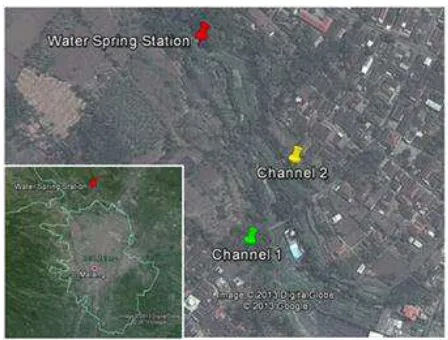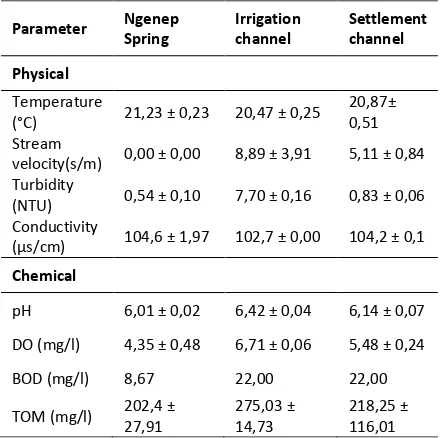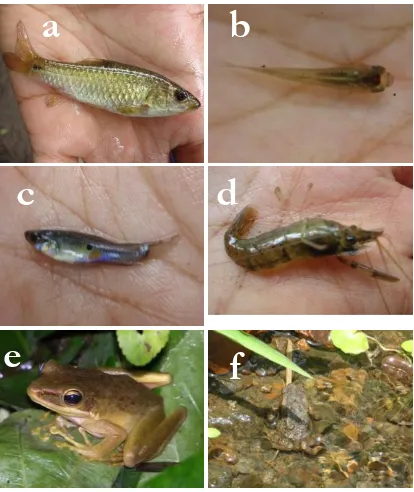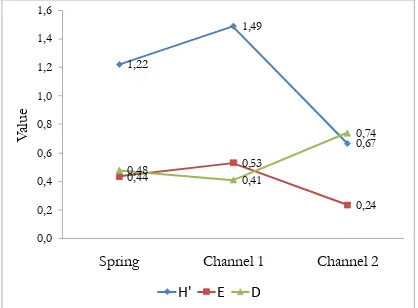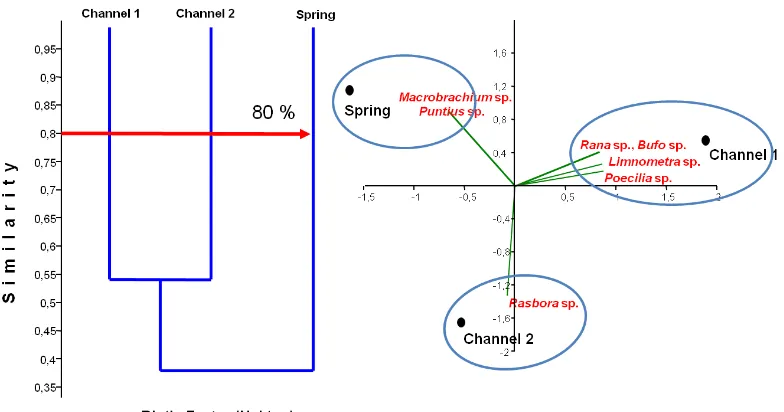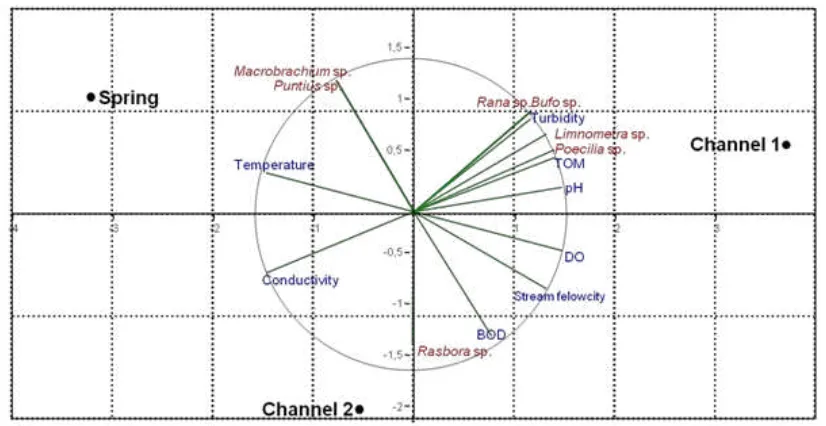J.Ind. Tour. Dev. Std., Vol.2, No.2, April, 2014 64
Spatial Diversity in Composition and Structure of Nekton in Ngenep Spring
and its Channels, Karangploso - Malang
Lia Hapsari
1,3, Maic Audo Lin Sihombing
1, Ade Meylisa Crystel Rohie
1, Catur
Retnaningdyah
21
Magister Program in Biology, Faculty of Mathematic and Natural Sciences, University of Brawijaya, Malang, East Java, Indonesia
2
Biologi Department, Faculty of Mathematics and Natural Sciences, Brawijaya University, Malang, East Java, Indonesia
3
Purwodadi Botanic Garden – Indonesian Institute of Sciences, Pasuruan, East Java, Indonesia
Abstract
Water springs and its channel degradation due to anthropogenic pollution may alter the community structure of aquatic organisms. Water spring degradation tehrefore affect the quality of water as tourism resources. This study aims to investigate the changes in community structure of nekton and determine the relationships between water quality characteristics to the diversity of nekton. The field survey was set up in Ngenep spring and its channels. Results showed that nekton species found in Ngenep spring and its channels consists of 4 classes, 4 orders, 6 families, and 7 species
with total 627 nekton samples. It is comprises of fishes, shrimp, frogs and waterstriders. Nekton diversity index (H’) in
the spring and irrigation channel were in moderate level (1<H'<3) while in settlement channel was low (0,67). Evenness values of nekton ranged 0,24 – 0,53, whereas dominancy index of nekton ranged 0,41 – 0,74. Evenness value in settlement channel was very low (0, 24) with high dominancy index (0, 74); it indicates that nekton species were spread not evenly in the channel, it dominated by fish Rasbora sp. (highest IVI, 184,95). There were spatial variations of physico-chemical water qualitiy parameters in Ngenep springs and its channels (temperature, stream velocity, turbidity, conductivity, pH, DO, BOD and TOM) which affected to nekton diversity and community structure. Clustering analyses and PCA result shows correlation pattern between nekton distribution with physico-chemical water quality parameters. However, physico-chemical water quality parameters in Ngenep springs and its channel were still optimum as nekton habitat (PP No. 82/ 2001).
Keywords: Community structure, Nekton, Spatial diversity, Spring, Water channel
INTRODUCTION
Springs are one of water sources that has an important role for various life purposes. Water springs not only used for daily life needs mainly by the surrounding communities, but also used as water source for agriculture irrigation, and tourism attractions. Malang Regency has been knowna s one of the nature based tourism destination, and water-based tourism recently grows significantly. Water springs is one of the crucial tourism resources, but many water springs in Malang experienced some decline, both in its quantity and quality [1].
There are several reasons for water spring degradation, namely due to many land use conversion from forest to agriculture particularlly in the hilly areas and landuses changes, sewage, forest degradation and pollutions. Anthropogenic activities such as settlements, agriculture practices, fishing, any households and other
Corresponding Address:
Email : [email protected]
Address : Jl. Surabaya – Malang KM 65, Pasuruan, East Java 67163, INDONESIA
human-induced problems surround the spring and its channel also directly and indirectly may polluted the waters, which in turn lead to the degradation of the spring and its channels. Water spring quality degradation due to pollution resulted form anthropogenic activities may alter the composition and community structure of aquatic organisms [2].
Recently, bioindicator widely used to determine the aquatic ecosystem health. Among bioindicator taxa, necton widely used due to its ability to provide aquatuc health status [3]. Nekton generally refers to free-swimming aquatic organisms including fish, amphibians, crustaceans, large aquatic insects large and other macroinvertebrate groups [4]. Nekton has the ability to move and migrates at many spatial and temporal levels. Nekton also corresponds to ecosystem changes resulting from anthropogenic impacts so that it can be used as bio-indicator of aquatic health [5]. Nekton species diversity in the waters may provide an overview of the complex nekton communities in the waters.
J.Ind. Tour. Dev. Std., Vol.2, No.2, April, 2014 65 ecological processes. There are interconnections
between the organisms and its environment as an ecological process that cannot be separated in the communities [6]. The community structure concept is very relevant applied to analyze the aquatic environment, because the composition and structure of a community is a good indicator to show where the community is located. Therefore, researches on habitat and comunity structure of nekton needed to conduct as a method to know the impact of changing water quality to the existence of nekton in water springs and its channel.
Ngenep spring is utilized by local surrounding communities for various purposes as water sources of drinking water, any households and sanitation, irrigation for many crops, also as structure and composition; relative abundance and frequency; diversity, similarity and dominancy indices of nekton in Ngenep spring and its channels due to anthropogenic activities, also to determine the relationships between its physico-chemical water quality characteristics to nekton diversity.
Results of this study provide ecological database of nekton diversity corresponds to ecosystem changes resulting from anthropogenic impacts in Ngenep spring and its channels, which may become basis for recommendations for the conservation of the spring, water managements and surrounding land-use in those area.
MATERIAL AND METHODS
Study Sites
Study area is located at Ngenep spring and its channels in Ngenep village, Karangploso district, Malang Regency. Malang regency is an area located in the South Central part of the East Java Province, coordinates position at 7° 44' to 8° 26' South Latitude and 112° 17' to 122° 57' East subdistricts and 90 householders [7].
This study was conducted in November 2013. Nekton sampling sites were set out into 3 stations; 1 station at the spring and 2 stations along the channels based on the anthropogenic activities i.e. irrigation channel (1) and settlement channel (2) with 3 sampling points per station using systematic random sampling (Figure 1).
Nekton Sampling
Visual concentration method were used to observe nekton diversity with quadrat plot sized 1m x 1m. Nektons present in the quadrat plots were recorded its type and amount then documented or photographed. Nekton samplings also conducted using nets with minimum mesh size of ± 1.5 to 2.0 mm. Nekton samples obtained put in labeled bottles and preserved with alcohol 70 % [8]. Data obtained were then identified by its morphological characteristics from literatures and analyzed in Laboratory of Ecology and Animal Diversity, Department of Biology, Faculty of Mathematics and Natural Sciences, Brawijaya University, Malang.
Water Quality
The spring and its channels were measured its dimensions including width (cm) and depth (cm). Water physico-chemical parameters were measured at sites and in laboratory by taking water samples per stations. Parameters observed including flow rates (only for channels), water temperature, secchi depth, turbidity, conductivity, pH, Dissolved Oxygen (DO), Biochemical Oxygen Demand (BOD) and Total Organic Matter (TOM).
Statistical Analysis
J.Ind. Tour. Dev. Std., Vol.2, No.2, April, 2014 66
a
b
c
d
RESULTS & DISCUSSIONS
Stations profiles and environmental conditions Nekton obervations were conducted at three stations (Figure 1):
a. Station 1 – Ngenep spring
Station 1 is located in upstream area of Ngenep spring with coordinates position at (07° 53'55.9” SL) and (112°36'77.75” EA), latitude 536 m a.s.l. (Figure 1, Figure 2-a). Waters in the spring in clear conditions dominated by rocks, sands and plant litters substrates and quiet-slow flowing stream. Some of riparian trees arround the spring including Syzigium pycnanthum,
Syzigium cumini, Ficus benyamina, Ficus sp., etc. Spring location is far from local settlements about ± 1 km.
b. Station 2 – Irrigation channels
Station 2 is located on channel of Ngenep spring use as irrigation of agricultural crops (rice/paddy and watercress) with coordinates posisiton at (07°53'55.9’’ SL) and (112°37'24 .0"EA), latitude 532 m a.s.l. (Figure 1, Figure 2-b). This station is divided into 3 sub-stations, with a plot size of ± 1 m, spacing between plots is ± 3m. In sub stations 1 and 2 are located in the area of irrigated rice farm, while the sub-station 3 is located in watercress farm. Water conditions in the third sub-station is very clear, with muddy and sandy base subtsrates, shallow depth, fast-flowing medium (0.26 m/sec).
c. Station 3
Station 3 is located in channel close to settlement area with coordinates position at (07°54'00.2” SL) and (112°37'27.3” EA), latitude 536 m. a.s.l. (Figure 1, Figure 2-c-d). The channel has rapid flow (0.15 m/sec), sandy and grassy base substrate. Residential distance to the station 3 is about ± 20 m, where there is a landfill located near station 3 so that many households waste scattered along the channel.
Physico-chemical water quality profile
Water quality measurements conducted prior to nekton samplings aim to investigate and determine the impact of changing water quality on nekton community structures in Ngenep spring and its channels. Profile of physico-chemical water quality results shown in Table 1.
Physical water quality
Water temperature at three stations ranged between 20-21 °C (Table 1). However the temperature of those three stations still suitable for aquatic organisms including nekton. Optimum
temperature for aquatic organisms ranges 20-30 °C [12]. The temperature variation were caused by the difference of time sampling and effect of the vegetation thickness around the waters allegedly blocking incoming sunlight penetration into the water.
Figure 1. Nekton sampling location map (Note: channel 1= irrigation, channel 2= settlement; source: google
earth, 2003).
Figure 2. Nekton sampling locations: (a) Ngenep spring, (b) settlement station, (c) irrigation channel watercress farm and (d) irrigation channel-ricefield.
Stream velocity in both channels ranged 5-8 sec/m (Table 1), defined as fast-flowing water stream. Stream velocity values were effected by the topography slopes from the spring toward its channels and type of substrates at base of the channels.
J.Ind. Tour. Dev. Std., Vol.2, No.2, April, 2014 67 the lowest while the in irrigation channel is the
highest about 7,70 NTU (Table 1). It is because in irrigation channel contains of many organic materials and mud substrates at base.
Conductivity indicates the ability of waters to conduct electricity depend on the concentration of ions and water temperature. Result showed that conductivity at all stations were in positive relation to the water temperature with their respective values >100 µs/cm, where the standard conductivity value range of 100-500 µs/cm [12].
Table 1. Profile of physico-chemical water quality in Ngenep spring and its channels.
Chemical water quality
pH value of the water is influenced by biological activity, temperature, oxygen content and the presence of water ions. Changes in pH value in the water shows the change of biological process and the supply of nutrients in the water. pH value in Ngenep springs tend to be neutral with value 6,01 ± 0,02, which it is good for fishing. Some aquatic biota are sensitive to pH changes and suitable with pH around 6.0 to 8.5 [13].
Dissolved oxygen (DO) is concentration of oxygen dissolved in the water. Oxygen is main components for respiration and metabolism of fish and other organisms resulted from phytoplankton and water-plants photosynthesis and air diffusion [14]. DO level in Ngenep springs and its channel at all stations ranged from 4.35 to 6.71 mg/l. Optimum DO level for fish growth was above 5 mg/l [15]. Spring station has the lowest
DO level because the waters at spring are not or slow-flowing stream. respiration of aquatic organisms. The organisms included nekton, benthos, plankton and plants. Result showed that irrigation channel has the highest level of 275.03 mg/l. This is due to the influence of organic material inputs to the channels agricultural waste, leaf litters and wood debris. TOM level considered normal ranged from 100-300 mg/l [16].
Identification and composition of Nekton Nekton species found in Ngenep spring and its channels (irrigation and settlement channels) consists of 4 classes, 6 families, and 7 spesies with total 627 nekton samples. It is comprises of fishes, shrimp, frogs and waterstriders. Fishes consists of 2 order i.e.
Cypriniformes (1 family, 2 species) and Cyprinodontiformes (1 family, 1 species); shrimp consist 1 order i.e. Decapoda (1 family, 1 species); waterstrider consist of 1 order i.e. Gerridae (1 family, 1 species); and frogs consist of 1 order i.e. Anura (2 family, 2 species) (Table 2.).
Morphological characteristics of 3 fish species: Wader Bintik Dua (Puntius sp.), sized small to medium, generally 100 mm in length, green to grey body colour, darker on dorsal and lighter in ventral. There are two dots at dorsal fin and middle of tail base (Figure 3-a). Wader Pari (Rasbora sp.) has slender body sized 70 mm at maximum, brown-yellow colour at dorsal and whitish at ventral. There are golden line inside and black line outside body in both side from gills to tail. (Figure 3-b). Cemplon/Gathul (Poecilia
sp.), sized 40-60 mm, male sized smaller 20–40 mm. Male Poecilia sp. has colourfull and bright scales males, some splashes, spots, or stripes in both sides body (Figure 3-c).
J.Ind. Tour. Dev. Std., Vol.2, No.2, April, 2014 68
Table 2. Nekton species found in Ngenep spring and its channels.
extrem swollen of its second pereiopods (Figure 3-d). Amphibians found from genus Rana and Bufo. Adult body of Rana sp. and Bufo sp. were eaasily distinguisheded by its shape and skin colour. Bufo has rounded body while Rana has slender body. Bufo skin is rough and dry with many pustules in brown colour, while Rana skin is smooth and wet, in bright colour due to chromatofor of black and brown also lipo which contain red, orange and yello colour (Figure 3-e-f) [17, 18, 19, 20]. Waterstrider (Limnometra sp.), is a true bug in the order Hemiptera, familiy Gerridae which distinguish themselves by having the ability to walk on water. They live on water surface either in stagnant waters or lentic areas of running waters. They usually large size in orange or red, black and yellow colour [21].
Figure 3. Nekton species found in Ngenep spring and its channels: (a) Puntius sp, (b) Rasbora sp., (c) Poecilia sp.,
(d) Macrobrachium sp., (e) Rana sp. (source:
alcander-clifford.blogspot.com) and (f) Bufo sp.
Relative abundance, relative frequency and importance value index of nekton
Importance value index obtained from the sum of variables measured (relative abundance and relative frequency). Nekton with high value indicated its significance position of the species within ecological community. Fish species Rasbora
sp. has the highest IVI, followed by Puntius sp. and
Poecilia sp. (Figure 4).
Relative abundance and relative frequency associated with distribution area or spreading of particular species. Results showed that Puntius sp.
and Macrobrachium sp. only found in Ngenep
spring, while amphibians Rana sp. and Bufo sp. only found in irrigation channel. Limnometra sp. found in both channels. It may indicated its spesific habitat and related to feedings abundance. In nature, fishes Cypirinidae family found in freshwater ranging from near shore to hilly areas 2,000 m above sea level. The fish is omnivorous; it feeds plankton, fito-plankton, insect larvae also plants. It is often found collaborated with other fish species in shallow ponds, spring, lakes and its channels, small to large rivers [21].
Diversity, evenness and dominancy indices of Nekton
Diversity index (H') nekton in Ngenep spring and its channels ranged from 0.67 to 1.49 (Figure 4). Nekton diversity in irrigation channels and spring were in moderate level (1<H'<3) while in settlement channel was low [9]. Evennes values of nekton ranged 0,24 – 0,53, whereas dominancy index of nekton ranged 0,41–0,74. Evenness values have negative relation to dominancy index. Evennes values in settlement channel were very low (0, 24) and high dominancy index (0,74) (Figure 5); it indicates that nekton species were spread not evenly, there are some individuals which dominated and found only in specific sations [4].
a
b
c
d
e
f
Local name Species Family Ordo Class
Ikan Wader Bintik Dua Puntius sp. Cyprinidae Cypriniformes Actinopterygii
Ikan Wader Pari Rasbora sp. Cyprinidae Cypriniformes Actinopterygii
Ikan Cemplon/Gathul Poecilia sp. Poeciliidae Cyprinodontiformes Actinopterygii
Udang Air Tawar Macrobrachium sp. Palaemonidae Decapoda Malacostraca
Water Strider Limnometra sp. Gerridae Hemiptera Insecta
Katak coklat Bufo sp. Bufonidae Anura Amphibia
J.Ind. Tour. Dev. Std., Vol.2, No.2, April, 2014 69 Figure 4. Bar chart importance value index (IVI) of nekton in Ngenep spring and its channels (Note: channel 1= irrigation,
channel 2= settlement)
Diversity indices results indicated that there are some nekton species which well adapt and breed in the spring habitat conditions and agricultural channels. In nature, fish species have a close relationship with habitat, physico-chemical water quality, changes of environmental quality, availability of feedings, feedings competitor, predators [22, 23]. Diversity indices values also influenced by the level of ecological pressure to the ecosystem of spring and its channels, for example as a result of human activities such as agricultures and dense settlements and other activities around the waters may caused degradation to the nekton diversity. Results showed that nekton diversity indices in settlement channel were the lowest and most degraded
Stations similarity cluster and PCA analysis based on physico-chemical water quality
Multivariate clustering based on its physico-chemical water quality of 3 stations were conducted using Bray-Curtis similarity index at 90 % (high level similarity) [24], result shows that that the stations were clustered into two groups
(Figure 6). Group 1 consists of settlement station (channel 2) and the spring. Water quality in both stations are in good quality with values of pH, temperature, turbidity, conductivity, DO and BOD are not much different (Table 1, Figure 6). Similarity of the two stations is presumably because the location is quite near to each other, channel 2 is located ± 300 m from the spring. Irrigation channel (alone) clustered in group 2. Waters in irrigation channel used for agricultural activities including rice and watercress. The presence of watercress indicate that the water is in good quality since watercress is sensitive plant to water quality changes, it grows optimum in good quality water. Physico-chemicals water quality parameter in irrigation channel differs from group 1 in stream velocity (fast-flowing), colder temperatures, higher level of DO, BOD and TOM (Table 1, Figure 6). It is allegedly due to many organic and anorganic materials produced by the crops.
Stations similarity cluster and PCA analysis based on nekton abundance
The degree of similarity between stations can also be viewed by biological parameters using Bray-Curtis index. Dendrogram (similarity index level at 80%) between the stations based on the abundance of nekton shows that it clustered into 3 groups respectively (Figure 7). It can be interpreted that each station has its typical of nekton abundance correspond to its habitat conditions.
Typical nekton abundance in spring station were Puntius sp. and Macrobrachium sp. Irrigation channel is characterized by the abundance of
Poecilia sp., Lymnometra sp., Rana sp. and Bufo
sp.; whereas in settlement channel characterized by the abundance of Rasbora sp. Irrigation channel and settlement channel have similarity of nekton abundance about 55%, some nekton species were found in both channels (Figure 7).
160,62
Puntius sp. Rasbora sp. Poecilia sp. Macrobrachium sp. Limnometra sp. Bufo sp. Rana sp.
J.Ind. Tour. Dev. Std., Vol.2, No.2, April, 2014 70
Figure 6 . Dendogram stations similarity cluster and PCA analysis based on physico-chemical water quality (Note: channel 1= irrigation, channel 2= settlement)
Figure 7. Dendogram stations similarity cluster and PCA analysis based on nekton abundance Note: channel 1= irrigation, channel 2= settlement)
PCA analysis correlation between nekton
abundance and water physico-chemical
parameter
PCA result in Figure 8 shows the correlation between nekton abundance with water physico-chemical parameters in Ngenep spring and its channel. The closer a variable angle to one another in the circle then the greater the role of the variables affect to each other. Nekton distribution variables at spring station are typically characterized by the presence of Puntius
sp. and Macrobrachium sp. in which do not
affected by the BOD level but affected by temperature. At the settlement channel, it is dominated by the presence of Rasbora sp. in which there are interactions with conductivity and BOD. Whereas in irrigation channel (channel 1) typically characterized by the presence of
Rana sp., Bufo sp., Limnometra sp. and Poecilia
sp., in which with many water quality variables affected including turbidity, TOM, pH, DO and stream velocity.
J.Ind. Tour. Dev. Std., Vol.2, No.2, April, 2014 71 Figure 8. Principal Component Analysis Graphic correlation between nekton abundance and water
physico-chemical parameter (Note: channel 1= irrigation, channel 2= settlement)
still optimum as nekton habitat according to PP No. 82 of 2001 concerning about the standard of water quality for fisheries. Spatial variation of physico-chemical water qualitiy parameters greatly affected to nekton community structure in Ngenep springs and its channel.
CONCLUSION
Human activities around the spring and its channels indeed gave impacts to nekton diversity and its water quality. Nekton species found in Ngenep spring and its channels (irrigation and settlement channels) consists of 4 classes, 4 orders, 6 families, and 7 spesies with total 627 nekton samples comprises of fishes, shrimp, frogs and waterstriders. Nekton diversity in irrigation channels and spring were in moderate level (1<H'<3) while in settlement channel was low. Anthropogenic activities in Ngenep springs and its channels have caused variation of physico-chemical water quality parameters which affected to nekton diversity and community structure. However, physico-chemical water quality parameters in Ngenep springs and its channel were still optimum as nekton habitat (PP No. 82/2001).
REFERENCES
[1]. Hakim, L. 2004. Dasar-dasar Ekowisata, Penerbit Bayu Media, Malang.
[2]. Ministry of Environment, 2005. State of the Environment in Indonesia, 2004. Ministry of Environement – Japan
International Cooperation Agency, Jakarta.
[3]. Septiani, Ervin, T. Setyawati, and A.H. Yanti. 2013. Kualitas Perairan Sungai Kapuas Kota Sintang Ditinjau dari Keanekaragaman Makrozoobenthos. Jurnal Protobiont 2013 Vol 2 (2): 70-74. [4]. Odum, E.P. 1996. Dasar-Dasar Ekologi.
Gajah Mada University Press. Yogyakarta. [5]. Raposa, K.B., C.T. Roman and J.F. Hetshe.
2003. Monitoring Nekto as Bioindicator in Shallow Estuarine Habitats. Environmental Monitoring and Assessment 81: 239–255. [6]. Buchar, T. 1998. Bioekologi Komunitas
Ikan di Danau Sabuah, Kabupaten Kapuas Propinsi Kalimantan Tengah. Tesis. Postgraduate Faculty. Bogor Agricultural University. Bogor (Unpublished).
[7]. http://malangkab.go.id. Accessed 12 November 2013.
[8]. Raposa, B.K. and C.T. Roman. 2001. Monitoring Nekton in Shallow Estuarine Habitat. A Protocol for Long-term Coastal Ecosystem Monitoring Program at Cape Cod National Seashore.
[9]. Krebs, C.J. 1989. Ecology Methodology. Hal.293-368. Harper Collins Publishers. New York. 694 p.
J.Ind. Tour. Dev. Std., Vol.2, No.2, April, 2014 72
[11]. Bengen, D.G. 2000. Tehnik Pengambilan Contoh dan Analisis Data Biofisik Sumberdaya Pesisir. Center of Coastal and Marine Resources Studies. Faculty of Fisheries and Marine Sciences. Bogor Agricultural University. Bogor.
[12]. Effendi, H. 2003. Telaah Kualitas Air bagi Pengelolaan Sumber Daya dan Lingkungan Perairan. Kanisius. Yogyakarta. 258 p. [13]. Pescod, NB. 1973. Investigation of
Rational Effluent and Stream for Tropical Countries, Asian Institute of Technology. Bangkok. Sgh.
[14]. APHA (American Public Health Association). 1989. Standard Methods for the Examination of Water and Wastewater. 17th ed. APHA, AWWA (American Water Work Association) and WPCF (Water Pollution Control Federation). Washington D. C. 3464 p. [15]. Karsoedi, K. 1989. Telaah Beberapa
Parameter Fisika, Kimia, dan Biologi di Sungai Cikaniki, Kawasan PT. Aneka Tambang UP. Emas Pongkor-Leuwiliang. Field Practice Report. Fishery Resources Study Program, Faculty of Fishery. Bogor Agricultural University. Bogor. (Unpublished).
[16]. Boyd, C. 1990. Water Quality in Ponds for Aquaculture. Alabama Agricultural Experiment Station, Aubum University, Birmingham Publishing Co., Birmingham, Alabama. 482 p.
[17]. http://fishbase.org. Accessed 29 November 2013.
[18]. Hillis, D.M. and T.P. Wilcox. 2005. Phylogeny of the New World true frogs (Rana). Molecular Phylogenetics and Evolutions 34: 299-314.
[19]. Supriadi, A. 2012. Keanekaragaman Jenis Udang Air Tawar di Sungai-sungai yang Berasal dari Gunung Salak. Skripsi. Biology Department. Faculty of Mathematic and Natural Sciences. Bogor Agricultural University. Bogor. (Unpublished).
[20]. Zettel. H. 2002. Limnometra spinosa, new species (Heteroptera: Gerridae), a Rare Water Strider from Indonesia and Malaysia. The Raffless Buletin of Zoology 50(1): 137-141.
[21]. Roberts, T.R.. 1989. The freshwater fishes of Western Borneo (Kalimantan Barat, Indonesia). Mem. Calif. Acad. Sci. 14:210 p.
[22]. Lagler, K.F. 1972. Freshwater Fishery Biology. 2nd Edition. Wm. C.Brown Company Publishers. Dubuque. Lowa. 421p.
[23]. Harteman, E. 1998. Afinitas Komunitas Ikan dengan Habitat di Sungai Kapuas, Kabupaten Kapuas, Kalimantan Tengah. Tesis. Postgraduate Faculty. Bogor Agricultural University. Bogor (Unpublished).
